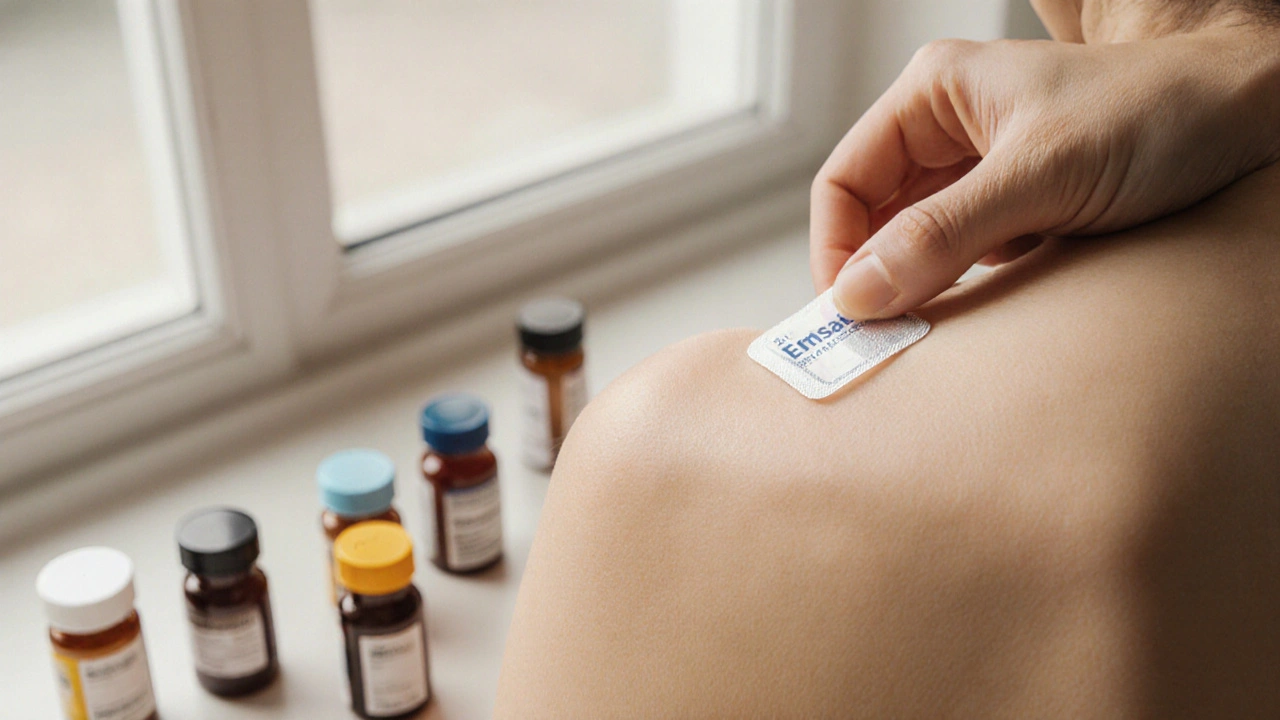Emsam vs Antidepressant Alternatives Comparison Tool
Recommended Antidepressant:
Emsam is a transdermal MAOI patch that offers a lower risk of tyramine reactions compared to oral MAOIs. It's ideal for those needing MAOI therapy without strict dietary restrictions.
Oral Selegiline is an alternative MAOI with similar efficacy but requires strict dietary control. It's less expensive but has more gastrointestinal side effects.
SSRIs/SNRIs are first-line treatments with fewer side effects and no dietary restrictions. They're effective but may not work for treatment-resistant cases.
Phenelzine is a potent MAOI with strong efficacy for atypical depression but carries high risk of hypertensive crisis due to dietary restrictions.
Bupropion is an atypical antidepressant that helps with fatigue and motivation but doesn't affect serotonin levels, making it suitable for combination therapy.
Key Takeaways
- Emsam delivers selegiline through the skin, avoiding many dietary restrictions of oral MAOIs.
- Oral selegiline, SSRIs, SNRIs, phenelzine and bupropion each have distinct efficacy, side‑effect and interaction profiles.
- Cost and convenience often tip the balance; the patch is pricier but may improve adherence.
- Patients with severe, treatment‑resistant depression often benefit most from MAOIs, including Emsam.
- Use the decision checklist to match your lifestyle, health history and symptom profile with the right medication.
When you or a loved one are sifting through depression meds, the headline question is often “Emsam vs alternatives - which works best for me?” This guide breaks down the transdermal patch known as Emsam, compares it side‑by‑side with the most common oral options, and hands you a practical checklist so you can move from confusion to confidence.
What is Emsam (Selegiline)?
Emsam is a prescription transdermal patch that releases the monoamine oxidase inhibitor (MAOI) selegiline through the skin. It was approved in the United States in 2006 for major depressive disorder (MDD) and later gained approval in the UK and EU for patients who have not responded to at least two other antidepressants.
How Emsam Works
The active ingredient, selegiline (a selective MAO‑B inhibitor at low doses, becoming a mixed MAO‑A/MAO‑B inhibitor at higher doses), blocks the breakdown of serotonin, dopamine and norepinephrine. By increasing the availability of these neurotransmitters, mood improves. The patch bypasses the digestive system, which means fewer dietary tyramine restrictions compared with oral MAOIs.

Typical Dosing and Administration
- Start with a 6mg/24h patch applied to a clean, dry, hair‑free area of the upper back or chest.
- After two weeks, clinicians may increase to 9mg/24h if response is inadequate.
- Patch is worn for 24hours, then removed and replaced with a fresh one at the same site.
Major Alternatives Overview
Below are the most frequently prescribed alternatives for adults with MDD. Each entry includes a brief definition, typical dose range, and a note on how it compares to the patch.
Oral Selegiline (the same MAOI molecule taken as a tablet)
- Usually 10mg daily for depression (higher than the 6mg patch).
- Requires strict tyramine diet because the gut exposure is higher.
- Less costly than the patch, but gastrointestinal side effects (nausea, constipation) are more common.
Sertraline (a selective serotonin reuptake inhibitor (SSRI))
- Typical dose: 50‑200mg daily.
- Well‑studied, favorable safety profile; no dietary restrictions.
- May be less effective for patients who have not responded to two other antidepressants.
Venlafaxine (a serotonin‑norepinephrine reuptake inhibitor (SNRI))
- Start 75mg daily, can be titrated to 225mg.
- Often helpful when both mood and pain symptoms co‑occur.
- Can raise blood pressure at higher doses; requires regular monitoring.
Phenelzine (a non‑selective MAOI)
- Typical dose: 15‑45mg daily.
- Strong dietary tyramine restrictions (cheese, wine, cured meats).
- Higher risk of hypertensive crisis but can be very effective for atypical depression.
Bupropion (an atypical antidepressant that inhibits norepinephrine‑dopamine reuptake)
- Standard dose: 150‑300mg daily (extended‑release).
- Stimulating effect helps with fatigue and low motivation.
- Does not raise serotonin, so it can be combined with an SSRI for augmentation.
Amitriptyline (a tricyclic antidepressant (TCA))
- Dose range: 25‑150mg nightly.
- Effective for insomnia and chronic pain but brings anticholinergic side effects (dry mouth, constipation).
- Overdose risk is higher than newer agents; requires careful prescribing.
Side‑Effect & Interaction Profile Comparison
| Medication | Class | Route | Typical Dose | Onset (weeks) | Response Rate | Common Side Effects | Major Interaction Risks | Approx. UK Cost* |
|---|---|---|---|---|---|---|---|---|
| Emsam | MAOI (selegiline) | Transdermal patch | 6‑9mg/24h | 2‑4 | ≈55% | Skin irritation, insomnia, headache | Reduced tyramine risk; watch SSRIs/SNRIs | £90‑£110 per month |
| Oral Selegiline | MAOI | Oral tablet | 10mg daily | 2‑4 | ≈50% | Nausea, dizziness, orthostatic hypotension | Strict tyramine diet; many drug combos | £30‑£45 per month |
| Sertraline | SSRI | Oral tablet/capsule | 50‑200mg daily | 1‑3 | ≈60% | Sexual dysfunction, GI upset, insomnia | Serotonin syndrome with other serotonergics | £5‑£12 per month (generic) |
| Venlafaxine | SNRI | Oral tablet | 75‑225mg daily | 2‑4 | ≈58% | Hypertension (high dose), nausea, sweating | SSRI/SNRI combo → serotonin syndrome | £8‑£15 per month |
| Phenelzine | Non‑selective MAOI | Oral tablet | 15‑45mg daily | 2‑4 | ≈60% | Weight gain, orthostatic hypotension | Severe tyramine reactions; many drug alerts | £25‑£35 per month |
| Bupropion | Atypical (NDRI) | Oral extended‑release | 150‑300mg daily | 2‑4 | ≈55% | Dry mouth, insomnia, seizure risk at high dose | Low serotonin interaction; watch stimulant combos | £12‑£20 per month |
| Amitriptyline | TCA | Oral tablet | 25‑150mg nightly | 2‑6 | ≈50% | Anticholinergic (dry mouth, blurred vision), cardiac effects | Risk with other QT‑prolonging meds; overdose danger | £4‑£10 per month |
*Costs are based on NHS prescription pricing and typical private pharmacy rates in 2025; actual out‑of‑pocket costs will vary with insurance and regional discounts.

Choosing the Right Option - Decision Checklist
- Dietary restrictions: If you cannot commit to a low‑tyramine diet, Emsam or another non‑MAOI is safer.
- Side‑effect tolerance: Sensitive skin → avoid patch; prone to sexual side effects → consider bupropion.
- Cost considerations: For tighter budgets, generic SSRIs/SNRIs and older TCAs are cheapest.
- Comorbid conditions: Chronic pain → venlafaxine or amitriptyline; fatigue/lack of motivation → bupropion.
- Previous treatment response: Failure after two different classes = consider an MAOI (Emsam or phenelzine).
- Adherence: Once‑daily patch removes pill‑burden; if you miss patch changes, efficacy drops.
Practical Tips for Switching to or from Emsat
- Consult your prescriber at least two weeks before changing any MAOI.
- If moving from an SSRI, implement a washout period of 5‑7days (longer for fluoxetine).
- Start with the lowest patch dose (6mg) to gauge tolerability.
- Rotate patch sites to avoid skin irritation - avoid the same spot for at least a week.
- Carry an emergency card noting you’re on an MAOI; alert dentists and surgeons before procedures.
Frequently Asked Questions
Can I drink alcohol while using Emsam?
Moderate alcohol is usually safe, but heavy binge drinking can increase the risk of hypertension with any MAOI. Keep consumption low and discuss your habits with your doctor.
How long does it take for the patch to work?
Most patients notice an improvement in mood within 2‑4 weeks, though some may need up to 6 weeks for full effect.
Is the patch safe for people with heart disease?
Because the patch causes less systemic MAO inhibition than oral forms, it is generally better tolerated in cardiac patients, but a cardiology review is still advised.
What should I do if I experience a severe skin reaction?
Remove the patch immediately, wash the area with mild soap, and contact your GP. A switch to oral selegiline or another class may be needed.
Can Emsam be combined with other antidepressants?
Combination is risky because of serotonin syndrome. If augmentation is required, clinicians often add low‑dose bupropion rather than another serotonergic drug.

Duke Gavrilovic
October 5, 2025 AT 13:50Interesting rundown of Emsam versus the usual oral meds. The patch does seem to cut down on the tyramine diet hassle, which is a big plus for many patients. I also appreciate the clear table comparing side‑effects and costs – it makes the decision process less intimidating. Overall, a solid resource for anyone weighing their options.
Abby VanSickle
October 6, 2025 AT 17:36Thank you for the thorough comparison; it certainly clarifies the trade‑offs between MAOIs and SSRIs. Patients often feel overwhelmed when considering dietary restrictions, so highlighting Emsam’s reduced risk is valuable. I also note the emphasis on monitoring blood pressure with venlafaxine – an essential safety point. Your guide should help many make an informed choice.
chris macdaddy
October 7, 2025 AT 21:23Yo, this is pretty helpful – especially the part about starting low with the patch. If you’re scared of stomach issues, the patch really sidesteps that compared to oral selegiline. Just remember the washout if you’re switching from an SSRI, otherwise you might end up with a nasty combo. Keep an eye on skin irritation, but overall it’s a legit option.
Moumita Bhaumik
October 9, 2025 AT 01:10Look, the pharma giants push these pricey patches to keep us dependent on big‑name drugs. They love to brag about "fewer dietary restrictions" while hiding the real cost and the subtle pressure to stay on brand‑name meds. If you can handle a regular diet, a cheap generic SSRI does the same job without the corporate markup. Don’t be fooled by the fancy marketing.
Sheila Hood
October 10, 2025 AT 04:56Oh sure, because patches are the pinnacle of psychiatric innovation.
Melissa Jansson
October 11, 2025 AT 08:43One must consider the pharmacokinetic paradigm shift introduced by transdermal delivery systems – a true epochal deviation from oral bioavailability constraints. The epidermal reservoir effect allows for a quasi‑steady‑state plasma concentration, mitigating peak‑trough fluctuations. Yet, the cost‑benefit calculus remains nuanced, especially when juxtaposed against the economic elasticity of generic SSRIs. In sum, the patch is a dazzling exemplar of pharmaceutical engineering, albeit with a premium price tag.
Max Rogers
October 12, 2025 AT 12:30The way you broke down the side‑effects table makes it much easier to compare. It’s also reassuring to see the emphasis on patient‑specific factors like budget and comorbidities. If someone is concerned about skin irritation, the advice to rotate sites is spot‑on. Overall, a very user‑friendly guide.
Louie Hadley
October 13, 2025 AT 16:16I like how the checklist puts the patient’s lifestyle front and center. Balancing efficacy with tolerability is key, and the guide does a good job highlighting that. The mention of combining bupropion for augmentation is a practical tip. Thanks for the balanced perspective.
Ginny Gladish
October 14, 2025 AT 20:03The comparative table is analytically sound; each variable is clearly delineated. Notably, the cost differentials underscore the socioeconomic dimension of treatment selection. However, the omission of long‑term adherence data for the patch is a gap that merits further study.
Faye Bormann
October 15, 2025 AT 23:50When navigating the labyrinth of antidepressant options, one quickly discovers that the decision matrix resembles a sprawling, multi‑dimensional chessboard, each piece representing a distinct pharmacological profile, each move affecting not only neurotransmitter levels but also lifestyle variables such as dietary constraints, economic considerations, and even personal philosophies regarding medication adherence. The Emsam patch, positioned as a strategic rook, offers a unique advantage by sidestepping the tyramine‑rich dietary minefield that ensnares many oral MAOIs, thereby granting patients a certain freedom of culinary expression that is often underappreciated in clinical discussions. Yet, this advantage does not come without its own set of trade‑offs; the transdermal route introduces potential dermatological complications, ranging from mild irritation to more severe contact dermatitis, a factor that must be weighed against the convenience of once‑daily application. Conversely, the venerable SSRIs, occupying the bishop’s diagonal, present a relatively low‑risk, high‑predictability pathway, albeit sometimes at the expense of sexual side‑effects and a modest latency period before therapeutic benefits become apparent. In the grand tapestry of treatment, SNRIs like venlafaxine serve as the knight, capable of leaping over comorbid pain syndromes with a dual‑action on serotonin and norepinephrine, yet they demand vigilant blood pressure monitoring at higher doses. Phenelzine, the queen of the board, exerts formidable power in refractory cases, though its reign is shackled by the most stringent dietary restrictions, rendering it less palatable for many. Bupropion, the humble pawn, propels patients forward with its energizing dopaminergic effect, a boon for those mired in fatigue, while simultaneously offering a safe platform for augmentation strategies without precipitating serotonin syndrome. As we consider cost dynamics, the patch’s premium price tag may be justified by improved adherence rates, yet for patients navigating limited insurance coverage, generic alternatives such as sertraline present an economically sustainable choice without compromising efficacy in many scenarios. Ultimately, the art of selecting the appropriate antidepressant mirrors a collaborative negotiation between clinician expertise, patient preference, and the evolving evidence base, a process that is both scientific and profoundly personal. By integrating tools like the decision checklist provided in the article, clinicians can facilitate a more transparent dialogue, empowering patients to make informed choices that align with their unique clinical and lifestyle contexts. Thus, the optimal pathway is rarely linear; it is instead a bespoke journey tailored to the individual’s neurochemical landscape, psychosocial environment, and logistical realities. In conclusion, while Emsam offers a compelling niche for those seeking MAOI benefits without the full burden of dietary vigilance, it is one piece of a larger therapeutic puzzle that must be assembled with care, compassion, and a commitment to ongoing assessment.
Kathy Butterfield
October 17, 2025 AT 03:36Great stuff, love the clear tables! 👍 The patch looks promising for folks who hate diet restrictions. 🌿
Zane Nelson
October 18, 2025 AT 07:23While the exposition attempts a comprehensive overview, it ultimately succumbs to a pedestrian collation of data without the requisite analytical profundity one would expect from a scholarly treatise. The author’s failure to engage with primary literature beyond superficial citations renders the piece an exercise in mediocrity. Moreover, the stylistic choices betray a penchant for bland summarization rather than genuine critical insight. In short, the article serves as a modest reference but lacks the rigor demanded by discerning clinicians.
Sahithi Bhasyam
October 19, 2025 AT 11:10Wow!! This guide is really helpful ;;; it covers everything from cost.. to side‑effects...!! 😊👍 I think the emojis add a nice touch... though I wish there were even more examples of real‑world scenarios!!!